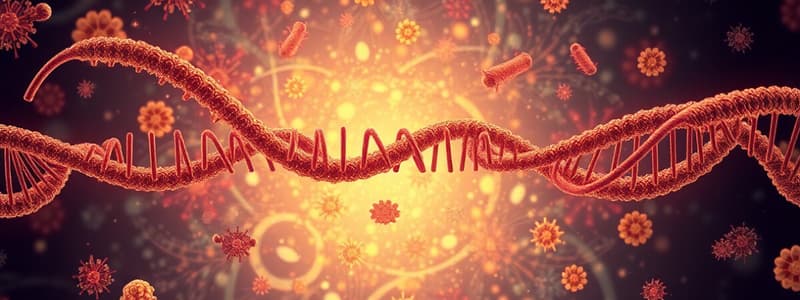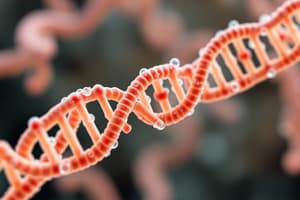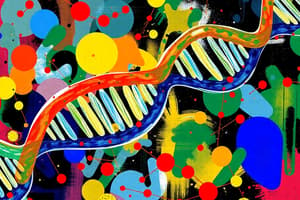Podcast
Questions and Answers
What is the role of the spliceosome?
What is the role of the spliceosome?
- To aid in the synthesis of proteins
- To remove introns from the mRNA (correct)
- To add a G-Cap to the mRNA
- To enhance the translation of mRNA
Exons are segments of RNA that are not translated into proteins.
Exons are segments of RNA that are not translated into proteins.
False (B)
What is added to the 5' end of mRNA to assist with ribosome binding?
What is added to the 5' end of mRNA to assist with ribosome binding?
G-Cap
The small nuclear _______ (abbreviation) are involved in recognizing and removing intron sequences.
The small nuclear _______ (abbreviation) are involved in recognizing and removing intron sequences.
Match the following terms with their descriptions:
Match the following terms with their descriptions:
What is the significance of alternative splicing?
What is the significance of alternative splicing?
The Poly-A tail consists of 50-300 dATP nucleotides.
The Poly-A tail consists of 50-300 dATP nucleotides.
What is the primary function of the Poly-A tail in mRNA?
What is the primary function of the Poly-A tail in mRNA?
Flashcards
mRNA Splicing
mRNA Splicing
The process of removing non-coding sequences (introns) from pre-mRNA, leaving only the coding sequences (exons) to be translated into proteins.
Introns
Introns
Non-coding sequences within pre-mRNA that are removed during splicing. They are not translated into proteins.
Exons
Exons
Coding sequences within pre-mRNA that are kept after splicing and used to create proteins. They contain the genetic code for the amino acid sequence.
Spliceosome
Spliceosome
Signup and view all the flashcards
snRNPs
snRNPs
Signup and view all the flashcards
Alternative Splicing
Alternative Splicing
Signup and view all the flashcards
G-Cap
G-Cap
Signup and view all the flashcards
Poly-A Tail
Poly-A Tail
Signup and view all the flashcards
Study Notes
mRNA Modification
- mRNA must be modified before leaving the nucleus
- Introns are removed, leaving only exons
- Small nuclear ribonucleoproteins (snRNPs) are crucial in this process:
- They cut out introns and join exons together
- Alternative splicing allows for different exon combinations, resulting in diverse protein products from a single gene
- A 5' cap (G-Cap) is added to the 5' end of the mRNA to facilitate ribosome binding
- A poly-A tail (50-300 adenine nucleotides) is added to the 3' end for protection from degradation
- Mature mRNA, containing only exons, the cap, and the tail, exits the nucleus to the cytoplasm
Mature mRNA
- Mature mRNA comprises only of exons, a 5' G-cap, and a 3' poly-A tail
- Mature mRNA leaves the nucleus and enters the cytoplasm, ready for translation
- Untranslated regions (UTRs) are present on both 5' and 3' ends, and these do not code for a protein sequence.
Studying That Suits You
Use AI to generate personalized quizzes and flashcards to suit your learning preferences.


